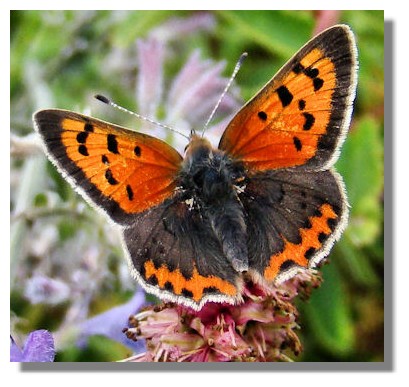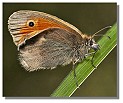
Butterflies of Scotland
- Small Copper (Lycaena phlaeas eleus)

This small (wingspan 3/4cm - 1.2/1.5 inches) butterfly is widespread through Britain and Ireland. The upperside forewings are a bright orange with a dark outside edge border with eight or nine black spots, with silver hairs along the trailing edges of the wings. The hindwings are dark with an orange border. The undersides are patterned in a similar way but are paler. The black spots on the forewings are outlined in yellow and the dark colouring is replaced by a pale brownish, gray. The hindwings are the same brown/grey colour with small black dots and a narrow orange border. The Small Copper is usually seen in ones and twos and males are very territorial and behave aggressively towards any passing insects, including butterflies much larger than themselves. Even the shadow of a large bird passing overhead is enough to get it going, returning to its basking spot when the chase is over. It is a common and widespread species across Europe, Asia and North America, and also found in North Africa, south through to Ethiopia. Its distribution becomes patchier in northern England, Scotland and Ireland. The Small Copper declined throughout its range during the twentieth century.
The Small copper's eggs are laid singly on the underside of foodplant leaves (dock, sorrel or sometimes knotgrass) and the young caterpillar feeds on the underside of the leaf creating "windows" by leaving the upper epidermis of the leaf untouched. The caterpillars (larvae) are usually green, but some have a purple stripe down the middle of the back and along each side. Pupation takes place in the leaf litter and the pupa is thought to be tended by ants. There are between two and three broods a year, fewer further north. The species overwinters as a caterpillar. Usually on the wing May to June and August to September with a 3rd brood flying in October and even as late as November.Depending on the habitat, Common Sorrel (Rumex acetosa) and Sheep's Sorrel (Rumex acetosella) are the two main food-plants, although other Docks (Rumex) species are occasionally used.
Return to the Butterfly Index
or go to the next Butterfly:  Small Heath.
Small Heath.
Where else would you like to go in Scotland?

